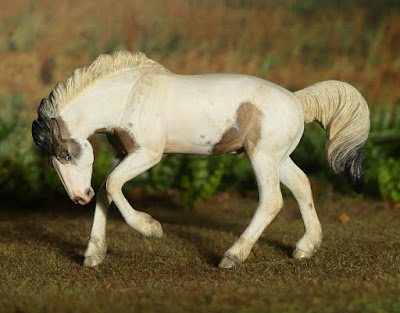One of the things I find most fascinating about the model horse hobby is how it can spark interest in real horse breeds from all over the world, which we might never have had any contact with in person, and never knew much about. I often find myself reading up on breeds to research possible colours to paint, or correct naming traditions, or even just to satisfy the curiosity to find out more about a breed I just bought a model of.
Last week, I emptied all the Stablemate bodies from my box and laid them out to see what I'd got left - any multiples of the same mould in there? Hmm, yes, there's several of the G4 ('rivet') mustang, let's have a mustang for a change. Better check if there's any colours I mustn't put on these...
Five hours later, I'm still oohing and ahhing over photos of mustangs in all kinds of colours, having read page after page by owners and enthusiasts, learnt a lot about the history of the breed and the strains with their differing characteristics, and I feel like I can add the mustang to the list of breeds I've never met but know a decent amount about.
Oh, and by the way, if you want a truly heartwarming horse story with a happy end (and who doesn't!), check out this Youtube video about Phoenix - and there's more about him, and all his herdmates, here.
So, feeling thoroughly primed by all these photos, I picked up the first mustang SM and started filing away the logo and seams, and considering colour options.
I've already done this mould in dark bay, wild bay, bay tobiano, and yellow dun; and while the blacks, greys & chestnuts are handsome, those are colours I've painted many times over on other moulds already, so the mustangs which stood out to try next were the roans, the more unusual pintos, and the various spotted patterns.
I mentioned in my last blog post that high on my little to-do list of coat colours I haven't painted before was a medicine hat pinto, so this seemed an ideal breed to carry that pattern, and I chose a grulla colour for the patches.
It's much more fiddly this way round, and getting the shading applied while staying 'inside the lines' is incredibly tricky. I had to use diluted paint dabbled on in thin loose layers a bit like watercolours, which really goes against the grain when I'm more of a smudgey, dry-brushing, thick-paint-in-thin-layers painter, but for a one-off technique improvised to achieve this pattern, it kind of worked!
The dark patch on his off side hock there is just shadow, not a marking, you can see in the next photo it's not really there.
This mould has really grown on me over the years, when I first saw it in the promo photos it looked very awkward and uncomfortable, almost a broken-backed pose, but real horses captured in motion do have some really gawky-looking phases in their gaits or movements, especially when bucking, squabbling, or larking about - and it's fine to have models which aren't doing perfect textbook poses!
Of course, while I was in a mustangy mood, I decided this boy needed a companion, so I went for another colour I'd admired in the real ones, a little like the now-famous Phoenix linked further up this post, but copied from this random Google Images photo I can't find an original source for - I liked the bigger blanket pattern, and the fact he's a slightly darker colour so my white paint would stand out more visibly.
I haven't managed to name either of these yet - I kind of feel they should have nature-based names as a nod to the wild outdoor life of their breed, but don't know anything about the native plants, trees, or wild birds of any home areas for the mustang herds, so that's more research to be done at some point!






No comments:
Post a Comment